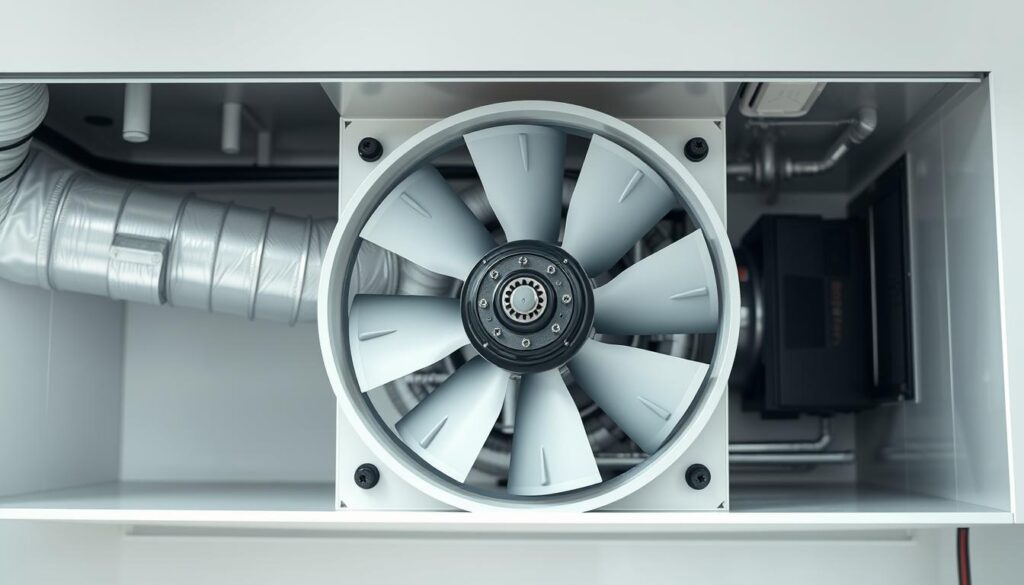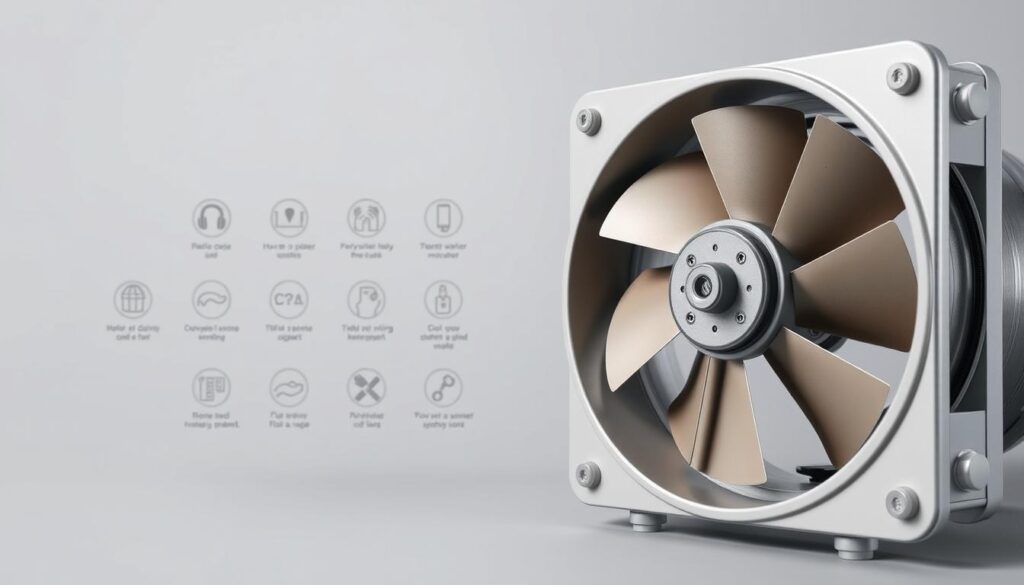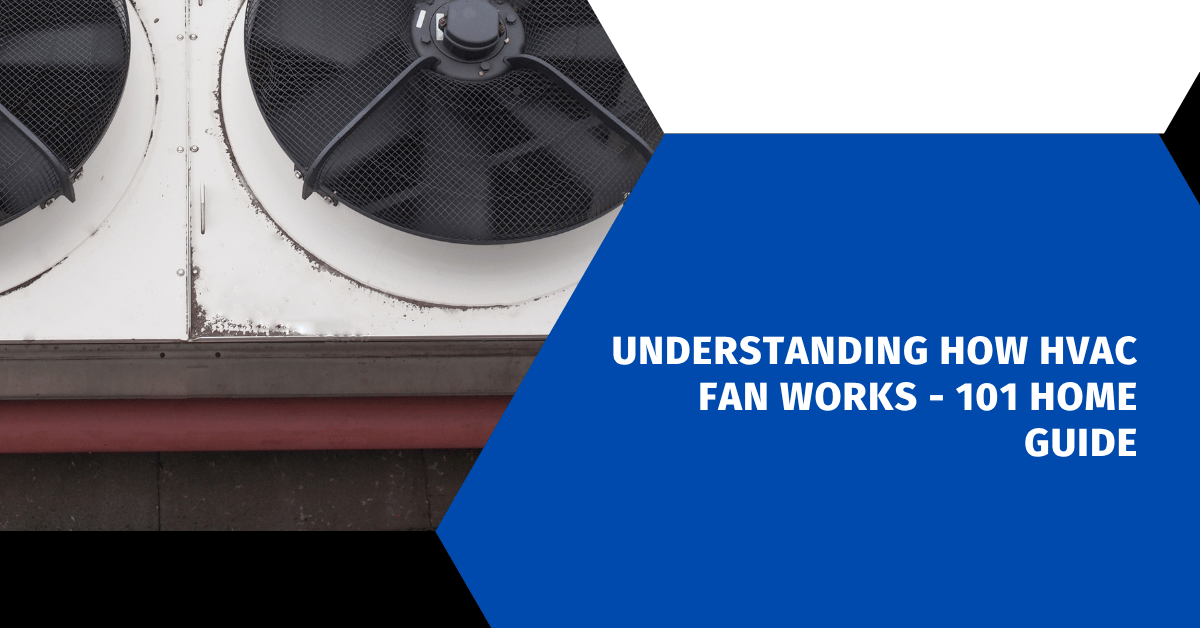Affiliate Disclosure
HVAC Guide Guys is a participant in the Amazon Services LLC Associates Program, an affiliate advertising program designed to provide a means for sites to earn advertising fees by advertising and linking to Amazon.
How HVAC Fan Works? Ever wondered how your home stays comfy all year? It’s thanks to your HVAC fan. This unsung hero works hard to keep your home’s climate just right.

HVAC systems are complex. They control temperature and air quality. The fan is key, moving air with great precision. These systems work all year, from heating in winter to cooling in summer.
Think of HVAC fans as a team of motors, blowers, and ductwork. They work together to control temperature. Modern systems can adjust to changes, keeping your home just right.
Key Takeaways
- HVAC fans are essential for circulating air throughout your home
- These systems work year-round to maintain comfortable temperatures
- Modern HVAC fans use advanced motor technologies
- Proper maintenance can significantly improve system efficiency
- HVAC fans play a critical role in indoor air quality
Table of Contents
The Role of HVAC Fan in Your Home Comfort System
Your home’s HVAC fan works hard to keep your living space comfortable. It circulates air all year round. This makes your home a cozy place to be.
Today’s homes use advanced hvac airflow systems for the perfect climate. Knowing how these systems work can boost your comfort and save energy.
Key Components of HVAC Fan System
- Blower motor: The heart of the air circulation system
- Fan blades: Responsible for moving air through ductwork
- Control mechanisms: Regulate fan speed and operation
How Air Distribution Works
The hvac ventilation system has many parts. Air circulation starts with the blower motor drawing air in. Then, it pushes air through ducts to every room.
“Proper air circulation is the key to maintaining a comfortable and healthy indoor environment.”
Impact on Indoor Climate Control
Your HVAC fan does more than just circulate air. It helps control temperature, air quality, and humidity.
- Temperature regulation
- Air quality maintenance
- Humidity control
Running an HVAC fan affects your home’s comfort and energy use. It uses about 500 watts of power. This can add $50 to your monthly bill.
Smart homeowners use their fans wisely. They set them to AUTO mode to save energy and improve air quality. Indoor air can be 2 to 5 times more polluted than outside air. Good air circulation is key for your health and comfort.
Types of HVAC Fans and Their Functions
It’s important to know about the different HVAC fans. They help keep your cooling and heating systems running well. Each fan has its own job in controlling air flow and temperature in your home.
HVAC systems use many fan designs. Each has its own features and uses:
- Propeller Fans: Great for low-pressure jobs
- Centrifugal Fans: Best for high-pressure duct systems
- Axial Fans: Perfect for moving air directly
“The right fan can dramatically improve your home’s comfort and energy efficiency.”
Now, let’s look at what makes each fan special:
| Fan Type | Key Characteristics | Best Applications |
|---|---|---|
| Axial Fans | Low cost, simple design | Cooling towers, outdoor condensers |
| Centrifugal Fans | Higher pressure, more noise | Air handling units, complex duct systems |
| Backward Inclined Fans | Most efficient design | Industrial and commercial HVAC systems |
When picking a fan, think about airflow, pressure, and what you need for comfort. An HVAC expert can guide you to the best fan for your home.
Explore Our HVAC Shop
Looking for top-rated HVAC tools, parts, and accessories? Visit our shop and find the perfect solution for your needs.
Visit the ShopHow HVAC Fan Works: Core Mechanisms and Operation
Knowing how HVAC fans work is key to keeping your home comfy and saving energy. The HVAC fan system is complex. It’s vital for moving air and controlling temperature.
Forced-air systems use blowers a lot. They make up about 75% of heating and cooling in homes. These blowers help move air well, keeping your home’s temperature and air quality steady.
Fan Motor Operation Principles
The HVAC fan motor is the system’s core. It powers air movement. Most air conditioners with a 5-ton capacity use a direct-drive PSC motor.
These motors have:
- A RUN winding
- A START winding
- A RUN capacitor that kicks in when the motor runs
Airflow Dynamics in HVAC Systems
Airflow is key to HVAC systems’ performance. Variable speed motors can save up to 30% more energy than single-speed motors. They move air at 400-600 CFM.
Efficient air circulation is the key to maintaining optimal home comfort and energy efficiency.
Speed Control and Performance Factors
Several things affect HVAC fan performance:
- Motor type
- Blade design
- System resistance
- Electrical efficiency
Over 50% of HVAC system failures are due to bad air filters. This shows how important regular maintenance is for fan performance.
| Motor Type | Energy Efficiency | Performance Characteristics |
|---|---|---|
| PSC Motor | Standard Efficiency | Fixed Speed Operation |
| ECM Motor | High Efficiency | Variable Speed Capability |
Explore Our HVAC Shop
Looking for top-rated HVAC tools, parts, and accessories? Visit our shop and find the perfect solution for your needs.
Visit the ShopEssential Components of HVAC Fan Assembly
Knowing the key parts of your HVAC fan assembly is key for comfort at home. The fan system has many important parts that work together well.

- HVAC fan motor: The power source for air movement
- HVAC fan blades: Move air through the system
- Mounting system: Keeps everything stable and reduces shaking
- Housing: Safeguards the parts inside and guides air flow
“The efficiency of your HVAC system depends on the precise interaction of its components.”
Now, let’s look at the main parts that make your HVAC system efficient:
| Component | Function | Typical Lifespan |
|---|---|---|
| HVAC Fan Motor | Drives fan blade rotation | 15-20 years |
| Fan Blades | Moves air through system | 10-15 years |
| Motor Housing | Protects internal mechanisms | 20+ years |
The choice of materials is vital for the durability of HVAC fan parts. High-quality materials like aluminum and treated steel help parts last longer and work better. The blower motor uses 50-300 watts, and variable-speed motors can save up to 40% energy.
Your HVAC fan assembly is made to move air well. Most systems can move over 400 cubic feet of air per minute. Keeping it well-maintained helps it work better and last longer.
Understanding HVAC Fan Motor Technologies
Your HVAC system’s heart is its fan motor. It’s key for comfort and saving energy. New HVAC fan motor technologies have changed how we control home temperatures. They offer better performance and savings.
The HVAC fan motor world is vast. Two main technologies lead the market: Permanent Split Capacitor (PSC) and Electronically Commutated Motors (ECMs). Each brings special features to your home’s heating and cooling.
PSC Motors vs ECM Motors
PSC motors run at a fixed speed. They use more electricity and are noisier. ECM motors are a big step up in HVAC fan motor tech:
- More precise speed control
- Significantly reduced energy consumption
- Lower operational noise levels
- Enhanced overall system efficiency
Variable Speed Technology
Variable speed technology lets your HVAC system adjust airflow as needed. This big leap in HVAC energy efficiency means your system can:
- Match exact cooling and heating demands
- Reduce energy waste
- Maintain more consistent indoor temperatures
- Improve air circulation
Energy Efficiency Features
Modern ECM motors can cut energy use by up to 30% compared to PSC motors. Investing in advanced motor technology saves money on bills and boosts home comfort.
“The future of home comfort is efficient, quiet, and intelligent motor technology.” – HVAC Innovation Experts
Explore Our HVAC Shop
Looking for top-rated HVAC tools, parts, and accessories? Visit our shop and find the perfect solution for your needs.
Visit the ShopCommon HVAC Fan Problems and Solutions

Knowing about common HVAC fan problems can save you a lot of trouble. Your home’s comfort depends on how well the HVAC fan works. Spotting early signs is key to keeping your HVAC system running smoothly.
Most HVAC fan problems come from electrical and mechanical issues. Here are some important facts:
- 70% of problems are due to electrical issues like blown fuses
- 25% need a pro to fix mechanical failures
- 15% are caused by bad wiring
- 20% come from thermostat problems
Diagnostic Warning Signs:
- Unusual grinding or squealing noises
- Weak or inconsistent airflow
- Complete fan motor failure
- Intermittent system performance
When you’re troubleshooting your HVAC, start with the basics:
- Check the thermostat battery
- Look at circuit breakers
- Clean or replace air filters
- Check fan blades for damage
“Regular maintenance can reduce HVAC failures by up to 50%” – HVAC Professionals Association
If simple checks don’t fix it, call a certified HVAC technician. They can catch small problems before they turn into big, expensive fixes.
Maximizing HVAC Fan Efficiency and Performance
To get the most out of your HVAC system, you need a plan and regular upkeep. Your home’s comfort and energy use depend on how well you take care of your HVAC.
Maintenance Best Practices
Keeping your HVAC in top shape is key for great airflow and energy use. Regular checks can save a lot of energy and make your system last longer.
- Replace air filters monthly to prevent airflow restrictions
- Schedule professional HVAC inspections annually
- Clean fan blades and exterior units every six months
- Check and seal ductwork for optimal air circulation
Energy-Saving Tips
Smart choices can make your HVAC system much more energy-efficient. These tips can cut down your energy use and lower your bills.
- Use programmable thermostats to optimize temperature settings
- Utilize ceiling fans to enhance air circulation
- Adjust thermostat by 3-5 degrees when away from home
- Invest in ENERGY STAR certified HVAC components
Optimal Settings Guide
Choosing the right fan settings can greatly improve your home’s comfort and energy use. Knowing how to adjust your system can lead to big efficiency gains.
“Small adjustments in your HVAC settings can result in up to 30% energy savings,” – HVAC Energy Experts
Follow these tips to boost your HVAC system’s performance and cut energy costs. Regular upkeep, smart settings, and modern tech can make your home more comfortable and efficient.
Modern Innovations in HVAC Fan Technology
The HVAC industry is changing fast, thanks to new fan technology. Modern hvac fan mechanisms are making home comfort systems smarter and more energy-efficient. They improve how well systems work and how comfortable they make us.
New technologies are changing how we think about hvac energy efficiency. Companies are making fans that move air better and use less energy. Some of these new features include:
- Variable-speed blowers that adjust performance based on cooling demands
- Smart fans integrating with home automation systems
- Ultra-quiet operation technologies
- Intelligent blade designs maximizing air circulation
“The future of HVAC technology lies in creating intelligent, responsive systems that adapt to user needs while minimizing energy consumption.” – HVAC Innovation Research Group
Technological advancements are making fans work better. Now, fans have sensors and AI controls that help manage temperature. This means fans can work smarter and use less energy.
| Innovation | Energy Savings | Performance Improvement |
|---|---|---|
| Variable-Speed Blowers | Up to 40% | Consistent Temperature Control |
| Smart Home Integration | Up to 30% | Personalized Comfort Settings |
| IoT-Enabled Fans | Up to 35% | Predictive Maintenance |
As technology keeps getting better, we’ll see even more advanced HVAC fan solutions. These will focus on both comfort and saving energy. The future of home climate control is looking smart, responsive, and green.
Explore Our HVAC Shop
Looking for top-rated HVAC tools, parts, and accessories? Visit our shop and find the perfect solution for your needs.
Visit the ShopProfessional Maintenance and Service Guidelines
Keeping your HVAC system in top shape needs a pro. They have the skills to handle complex problems that could harm your cooling and heating systems.
“Regular professional maintenance is the key to preventing unexpected breakdowns and extending your HVAC system’s life.”
When should you call a professional? Look out for these signs:
- Unusual noises from the blower
- Complete loss of airflow
- System running constantly without cooling effectively
- Frequent system cycling
- Unexpected increases in electric bills
Professional maintenance is a big plus. It can stop up to 30% of equipment failures by catching small problems early. An annual check can add 5 to 15 years to your HVAC’s life.
Here are some maintenance tips:
- Biannual professional inspections
- Filter replacements every 1-3 months
- Electrical connection checks
- Refrigerant level monitoring
- Ductwork evaluation
Professional care can make your system 5% to 15% more energy-efficient. This can lower your energy bills and avoid expensive fixes.
Conclusion
Knowing how HVAC fans work is key to a comfy and energy-saving home. You now understand how to make the best choices for your cooling and heating. This knowledge helps you control your home’s climate better.
Keeping your HVAC system in top shape is essential. AC fans are vital for cooling, using about 51.4 kWh daily. By following this guide, you can cut down on energy use and make your HVAC last longer. Proper fan care can also save you money, from $44 to $231.45 a month.
Your home’s comfort depends on your HVAC fan’s performance. Whether it’s a ceiling fan or a full system, knowing how it works is important. Good ventilation, efficient cooling, and smart temperature control are vital for a great indoor space.
HVAC fan systems are getting smarter with new tech. Keep up with the latest, maintain your system well, and seek help from pros when needed. Your efforts will lead to a cool, efficient, and reliable home system for years.

